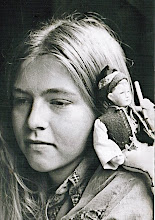This amusing postcard is from around 1905. You can tell it's earlier than 1907, because it has an undivided back, which only allows for the address on the backside. If people wanted to write messages on postcards at that time, they had to write on the picture side or not write one at all. So, you might receive a mysterious postcard with no message and be left wondering who sent it and what they intended. In 1907, U.S. postcards were made with a divided back with space for both the address and a message. That's when the fun really started.
At the time of this postcard, there were just over three million telephones in the United States, all connected by manual telephone exchanges. (Note: Today there are over 100 million
cell phone subscribers in the U.S.) Manual exchange meant that every call you made went through an operator; there were no numbers to dial yourself. If the number you were calling was in the same exchange, the operator would simply connect the lines on the switchboard. If it was in another exchange, she would have to connect with the operator at that exchange and ask her to connect the call. Long distance calls were pricey though, so you didn't want to make very many of them or stay on the line too long. I don't know the significance of the 999 number; it's the emergency number in a lot of countries, but not in the U.S.





















